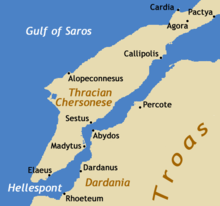Gelibolu Peninsula
| Gallipoli Peninsula | ||
 Gallipoli Peninsula |
||
| Geographical location | ||
|
|
||
| Coordinates | 40 ° 21 ′ N , 26 ° 28 ′ E | |
| Waters 1 | Sea of Marmara , Dardanelles | |
| Waters 2 | Bay of Saros in the Thracian Sea | |
| length | 83 km | |
| width | 21 km | |
| surface | 900 km² | |
 Kilitbahir fortress at the narrowest point of the Dardanelles at Eceabat |
||
Gelibolu Peninsula , formerly Gallipoli ( Greek Χερσόνησος της Καλλίπολης Chersonisos tis Kallipolis , Turkish Gelibolu Yarımadası ), is the modern name of the ancient Thracian Chersonese ( Χερασrakνησος ερασνησος ).
The peninsula belonging to Turkey separates the Sea of Marmara and the Dardanelles from the Bay of Saros in the Thracian Sea . The largest city on the peninsula is Gelibolu .
links
The peninsula can only be reached from Thrace via the main road from Keşan or via small mountain roads from Şarköy ( Tekirdağ ) and from Asia Minor only via the ferries from Lapseki to Gelibolu and from Çanakkale to Eceabat .
The Turkish island of Gökçeada ( Imbros in Greek ) can be reached from the western side .
geology
The Gelibolu Peninsula is located on the Anatolian Plate on the northern plate boundary with the European Plate .
history
The peninsula served Alexander the Great in 334 BC. As the starting point for his campaign in Asia. From here he crossed the Hellespont ( Dardanelles ) with 30,000 foot soldiers and 5,000 riders .
In the opposite direction, the peninsula served the Ottoman Empire as a bridgehead for expansion into Europe. The conquest of Gallipolis in 1354 was followed by the conquest of Thrace and the "encirclement" of Constantinople , which fell to the Ottomans almost 100 years later.
During the First World War , the Battle of Gallipoli took place in February 1915 . The invasion of the Ottoman Empire by the Entente powers failed and ended with the evacuation, which lasted until January 1916.
After the Russian Civil War , a large Russian military camp of General Baron von Wrangel's troops was built on the Gallipoli peninsula in 1920 .
Attractions
- Gallipolli battlefields
- Çanakkale Şehitleri Anıtı
Ancient cities
- Alopekonnesos, place of origin of the Platonic philosopher Manaichmos
- Lysimacheia , formerly Kardia
- Sestos
See also
literature
- Johannes Krauss: The inscriptions of Sestos and the Thracian Chersonese (= inscriptions of Greek cities from Asia Minor . Volume 19). Habelt, Bonn 1980, ISBN 3-7749-1750-7 .

